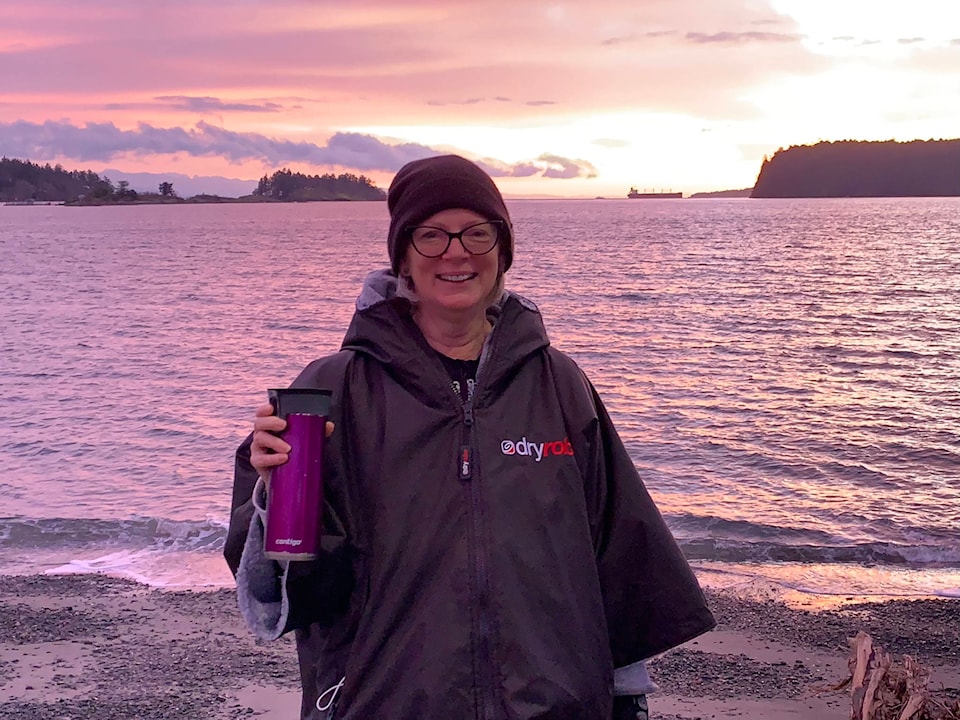The cure for the COVID-19 blues was as close as a dip at the nearest beach for one Nanaimo woman.
A healthy, strong swimmer, McLeod was invited by to try a full-moon swim at a local beach in late November. The idea gave her pause.
тАЬIтАЩd only lived here for about six months when COVID hit, so itтАЩs been difficult to meet new people and develop community,тАЭ McLeod said. тАЬI had never really considered swimming in winter and only very occasionally gone swimming outdoors at night. Honestly, at first it seemed like a crazy idea to me, but I decided тАШWhat the heck,тАЩ and took the plunge.тАЭ
McLeod said the first time she ran into the water and immediately ran back out.
тАЬI am sure I wasnтАЩt in for more than 30 seconds,тАЭ she said. тАЬI was amazed at how shockingly cold it was. Despite the cold, there was something really beautiful about being in the sea at night, and even though my fingers and feet were particularly painful and numb I felt remarkably good afterward.тАЭ
Now, when McLeod wants to chill out, she takes a polar bear approach. While the idea of тАЬwild swimmingтАЭ тАФ swimming in any natural body of water тАУ isnтАЩt a new concept, taking to a lake, river, pond or the open Pacific in the dead of winter or even early spring may sound extreme.
But still, thereтАЩs a growing interest in year-round wild swimming, including winter swimming in northern climates.
McLeod connects with other experienced swimmers, meeting up a couple of times a week тАУ masking up and keeping their distance. McLeod is building up her time in the water and her tolerance for the cold, staying in for up to 10 minutes.
According to , the Pacific temperature in Nanaimo ranges from an average of seven degrees Celsius in the winter to an average of 17 degrees Celsius in the summer.
тАЬThroughout the year, the water temperature in Nanaimo does not rise above 20┬░C/68┬░F and therefore is not suitable for comfortable swimming,тАЭ the site says.
ThatтАЩs putting it mildly. Wild swimming is only recommended for experienced, healthy swimmers with company. Individuals with health issues, such as heart conditions, blood pressure problems or asthma should consult their physician on the advisability of wild swimming.
тАЬTolerance is very individual, however, and cold-water swimming, or dipping, is definitely a shock to the system,тАЭ McLeod said.
At any time of year, wild swimming can be dangerous, McLeod noted. In the winter, cold and hypothermia present heightened risk.
тАЬItтАЩs very important that you know how to swim, for example, and that you know your limits,тАЭ she said. тАЬA wild swimmer needs to be aware of things like tide, waves, current and water temperature. Generally, itтАЩa good practice to swim with a buddy, and certainly do not swim alone at night.тАЭ
A healthy respect for the environment and those that share it is also important, she added, citing the time she had to avoid a raft of sea lions.
In addition to a bathing suit, there is other recommended gear. Neoprene glovesтАФavailable at sporting goods stores or surf shopsтАФhelp, as do water shoes or diving boots, especially on rocky beaches. Cover-ups for changing to get warm and dry immediately afterward are important, and swimmers beat a path to their car right away, she said.
Just a few months into her new passion, McLeod swears by the touted benefits of cold-water swimming: burning calories, boosting the immune system, increasing circulation, reducing inflammation and offering a natural high through endorphin release and the painkilling effect of the cold.
тАЬFor me, the most significant impact is on my mood,тАЭ said McLeod. тАЬI find a winter dip brings me completely into the present moment, pushing all other concerns and worries out of my head. I become immediately and exquisitely aware of my breathing, my limbs and the water and sky that surround me. This is a huge positive boost that last for hours afterward.тАЭ
McLeodтАЩs blog can be read . To learn more about wild swimming and to get important safety information and other tips, visit .
For more news from Vancouver Island and beyond delivered daily into your inbox, please



